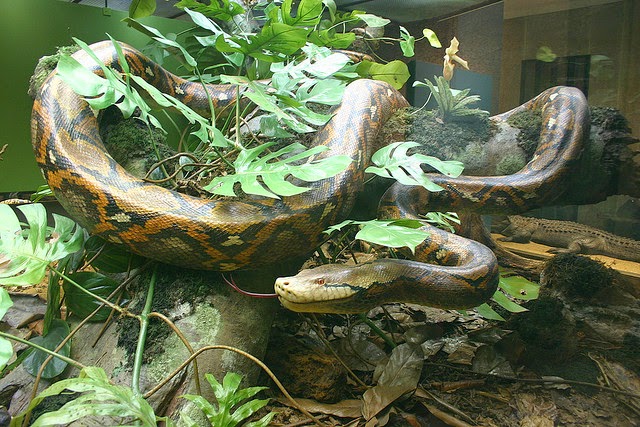The latest additions to “creatures we thought reproduced sexually but turn out to be able to reproduce asexually” is a pretty spectacular one, because one of the two species is one of the biggest snakes in the world.
A paper published back in June by Booth and colleagues is suddenly making the rounds on news and social media. It describes research on two python species, the reticulated python (pictured, record holder for longest snake), and the royal python. While the news is focusing on “snake gives virgin birth!” angle, this paper is far more interesting.
The major question in this paper is: how do animals switch, genetically, from sexual to asexual reproduction? In most vertebrates - including the two in this paper - the answer is “terminal fusion automixis.”
In most female vertebrates, gametes divide unevenly in meiosis, with one large cell set to become the egg, and the other becoming a “polar body,” which normally dies. Some species are able to take the polar body and have it act like a sperm cell. The offspring that result are not genetically identical to their mother, because there is a a random element in meiosis.
There’s been
one apparent exception: a Burmese python reproduced without sex, and the offspring were clones of the mother. If so, the offspring could
not have been generated by terminal fusion automixis. This would be weird, given that this is out of step with an increasingly large number of cases.
Booth and colleagues, however, describe some unpublished data from another Burmese python laying eggs without sex. Here, the offspring are apparently not clones of the mother, which is in line with other species, but not the one previous account. Because of this, Booth and company suggest the previous paper be “viewed cautiously.”
This would be the normal translation from academese:
Booth and colleagues suggest that the first clone python report is not due to an error. Instead, they suggest that an individual, which had been created by parthenogentic reproduction, reproduced again by the same means. They write:
If this is indeed the
case, this would represent the first documentation of such reproductive
competence of (facultative parthenogensis) in vertebrates.
Only time (and a few more replications) will tell if there are indeed clone snakes. If there are, they seem to be rare.
Hat tip to Jason Goldman.
Reference
Booth W, Schuett GW, Ridgway A, Buxton DW, Castoe TA, Bastone G, Bennett C, McMahan W. 2014. New insights on facultative parthenogenesis in pythons.
Biological Journal of the Linnean Society 112(3): 461–468.
http://onlinelibrary.wiley.com/doi/10.1111/bij.12286/full
External links
Virgin Birth Discovered In The World's Largest Snake
Python babies the result of 'virgin birth,' zoo confirms
Photo by Ryan Somma on
Flickr; used under a Creative Commons license. Graffiti picture from
here.
 A New Yorker article starts off talking about killing an awful lot of rats on New Zealand, but makes its way to discussing invasive species more generally:
A New Yorker article starts off talking about killing an awful lot of rats on New Zealand, but makes its way to discussing invasive species more generally:

























